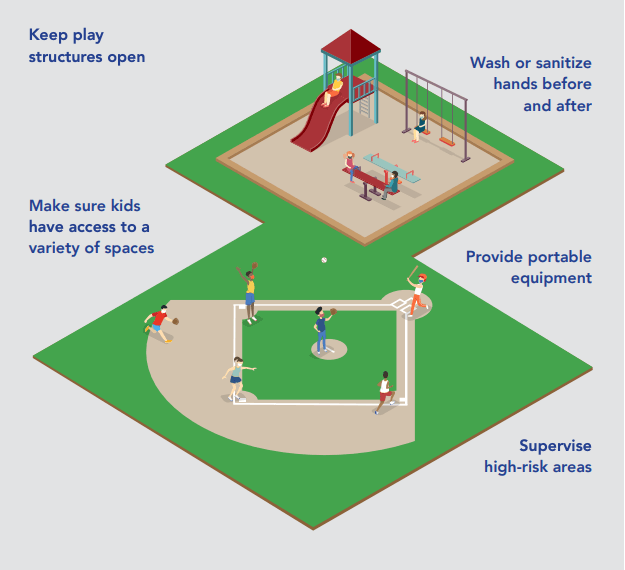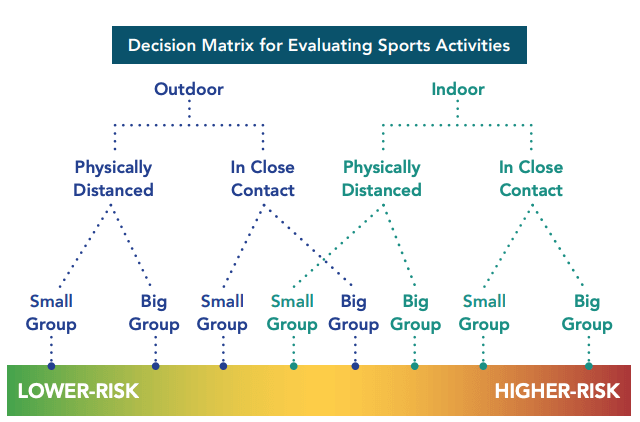Schools are an avenue for participation in a number of activities outside of the traditional classroom environment. As much as possible, these activities should continue to be provided to students to support engagement, health, mental wellbeing, and development.
Recess, often the only opportunity to participate in unstructured free-play during the otherwise structured and sedentary school day, is beneficial to children’s development of autonomy, participation in physical activity and various sensory and physical experiences, practice of social and motor skills, and attention restoration. As different areas of the schoolyard afford different levels of physical activity, types of play, and social interactions, consider the impact of new recess policies on children’s ability to confer the benefits of recess. Schools can develop strategies to reduce the risk of COVID-19 transmission in order to allow for continued use of fixed equipment (play structures) and portable equipment.
One of the most important steps that can be taken is for children and teachers to wash their hands with soap and water both before and after recess. Hand sanitizer containing at least 60% ethanol or 70% isopropanol can be used in situations when this is not feasible. Schools may consider having students use hand sanitizer before and after using high-touch equipment (e.g., fixed equipment or play structures). Supervision could be increased to ensure safe practices are followed, particularly during high-risk times (start/end of recess) and in high-risk locations (enclosed or small, hard-to-see places on fixed equipment, or anywhere with high child density). Supervisors should maintain physical distance from students and continue to wear masks. Physical distance between students should be promoted as much as possible. Schools may consider offering physical activity options that allow students to maintain physical distance while they are playing. However, transient interactions while masked are lower risk and should not be used as the basis for limiting all activities.
Ideally, recess times could be staggered so that children in different classes or cohorts would not interact (to maintain group distancing). If classes or cohorts must share the same recess time, entry and exit times could be staggered, or different entry and exit locations could be used for each group. If the schoolyard is large and diverse enough to provide adequate space and variety to each class (including access to all types of schoolyard locations and equipment), classes or cohorts could be provided with designated spaces on the schoolyard in which to play (if recess times cannot be staggered). These designated spaces could be rotated frequently (e.g., daily, weekly, depending on the variety available) to provide children access to a variety of schoolyard experiences.
Schools can allow use of shared portable equipment (e.g., balls, wheeled toys) as play with portable equipment promotes physical activity and allows children to practice motor and social skills. Shared equipment can be disinfected between each class/cohort, and students should wash hands after using shared equipment. Schools may also allow children to “sign out” pieces of equipment and clean each piece between uses. When possible, schools could consider how to modify games/activities to promote safe play. For example, the game “tag” could be replaced with “shadow tag,” in which children step on each other’s shadows instead of touching each other directly.

Physical education aims to develop children into physically literate individuals who have the skills, fitness, and motivation necessary to participate in physical activity across the lifespan. Importantly, while both facilitate physical activity participation, recess and physical education have unique benefits and should not be substituted for one another.
When designing lesson plans, schools could choose activities that limit the amount of shared equipment (e.g., children rotate through stations and equipment is cleaned before/after each use) and contact between students (e.g., children have their own pool noodle to tag others with instead of their hands and to remember to keep distance). As some children may be less physically fit due to limited participation in activities over the previous months, schools could apply progressive overload to allow for safe, gradual increases in workload. Physical distancing, washing hands, and healthy building strategies are particularly important during indoor physical education due to increased breathing rates of students. Locker room access should be limited or staggered. Furthermore, physical education is much more than just physical activity, so schools may consider focusing on teaching the components and values of physical activity and physical fitness, as well.
Music education is associated with numerous benefits, including higher academic scores, better memory recall, and the development of areas of the brain related to language and reasoning. Music and theater education should continue, but there are ways they can be made safer. Instruments that do not involve blowing air from the mouth, such as percussion or strings instruments, could be used instead of higherrisk wind instruments, which have the potential for spread of aerosols and droplets because masks cannot be worn while playing. Singing and voice projection are also higher-risk activities that carry a higher risk of viral transmission because of the higher emission rates of aerosols and droplets. Indoor instruction of these higher-risk activities can be replaced with outdoor practice (weather permitting), music theory, theater history, or vocal anatomy lessons. Another option is to continue online instruction for certain instruments, choirs, or ensembles, or practice outdoors in smaller, well-spaced groups. If schools decide to practice indoors, additional precautions are necessary. Practice should only take place in rooms with enhanced ventilation and filtration and where maximum physical distancing can be achieved (minimum six feet). Additional distancing beyond six feet is required for unmasked wind instrument players. Masks should be worn at all times for string instruments players, singers, and performers who are projecting their voice, and for wind instrument players at all times when not actively playing the instrument (e.g., during instrument setup, between songs).
Additionally, all equipment, even student’s personal instruments, should be cleaned routinely. Smaller music spaces such as individual practice rooms may be difficult to properly ventilate, so there should be time set aside to keep the door open and clean the room in between uses, or the rooms can be temporarily closed. In theater classes, it may be preferable to focus on rehearsing monologues, remote performances, more performances with small casts that do not require close interaction or performances that can be rehearsed outdoors.
Sport participation offers students a number of psychological and physical benefits and drives physical activity both in childhood and later in adulthood. The risk of transmission for each sport will depend on a number of factors, so decisions regarding specific sports will need to be nuanced. All sports carry some risk of transmission, and that risk varies by the activity. For example, some sports may be a higher risk during competition but can be a lower risk during practice and drills. But even for sports with lower overall risk, there can be periods of higher risk times during practice or in the locker room. The overall risk is not necessarily about the sport, per se, but about the activities taking place within each sport. The flow chart provided in this section may help decision-makers identify the overall risk level of sports activities across three factors: location, distancing, and group size.

Outdoor sports may be less risky than indoor sports, so hold as many practices and games outdoors as possible. Individuals being in close contact increases risk of transmission, so strategies to limit close contact of players should be employed. For example, limit full gameplay to competitions and focus practices on other elements of skill development. Also, consider limiting the number of competitions in a season overall or hold within-team or within-school competitions. To the extent possible, teams should avoid competing with teams that are not local or not part of their conference or league. If big groups are present during the sport, implement strategies to de-densify (e.g., alternate work out days/times for different parts of the team) and maintain physical distancing as much as possible. Teams may also consider ways to shorten the duration of time spent indoors for a particular practice or competition when feasible.
Regardless of overall risk level, there are some strategies that can be implemented in all sports to reduce risk of transmission. An overarching goal is to limit shared spaces and close contact. This means not using locker rooms or staggering locker room use, and avoiding team huddles and high fives, and washing hands or using hand sanitizer frequently. In-person meetings (e.g., team meetings) should take place remotely, outdoors, or in spaces where physical distancing can be maintained. Workouts, practices, and drills could be completed individually or in small cohorts to maintain physical distancing and so that equipment can be cleaned between uses. A certain number of practices per week could also be dedicated to at-home workouts.
Consider limiting the number of competitions in a season overall or hold within-team or within school competitions. To the extent possible, teams should avoid competing with teams that are not local or not part of their
conference or league.
The number of people in direct contact with the team and/or staff can be reduced by eliminating or limiting the number of attendees and other non-essential personnel at sporting events. Physical distance between spectators should be maintained, and schools should clearly mark six foot distances in lines, hallways, and/ or seating. Spectators, if allowed at all, should wear masks and be asked to bring signs and applaud the players instead of yelling and cheering; playing music on a loudspeaker at certain times during the event may help improve energy without the cheering.
To limit risk during practices and competitions, players, coaches, and attendees should wear face masks at all times, including on the sidelines/bench, in locker rooms, and/or during gameplay. To ensure anyone wearing masks stays hydrated, they should be encouraged to take mask-free water breaks, while physically distanced from others and while following safe mask removal techniques (e.g. only touching the mask from its straps). Team members could have a spare in case the mask gets too sweaty. In addition, coaches can create areas far removed from other people and near areas of good ventilation where athletes can take short mask breaks (e.g., near the gym door). Athletes with asthma or other breathing problems should consult with their physician if there are concerns about mask use during physical activity. Finally, coaches are recommended to analyze every element of practices and games to identify ways to reduce risk, such as using hand or electronic whistles instead of whistles that touch the mouth, and to consider sport-specific strategies.
Children in older grades often have more freedom than younger children. Although breaks from classes are important, safety precautions need to be maintained. When possible, schools could have students spend free blocks outside where there is more fresh air, and physical distancing is easier. If inside, schools may consider assigning student classes to specific common spaces (to preserve group distancing), putting limits on the number of students allowed in each space, and creating clear rules and demarcations on how to maintain physical distance. To limit unsupervised time further, schools may consider entirely replacing free blocks with supervised study halls.
When possible, schools could have students spend free blocks outside where there is more fresh air, and physical distancing is easier.